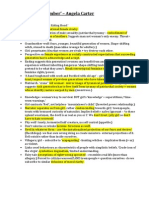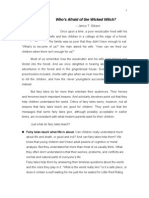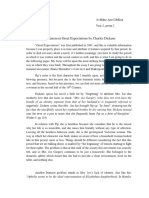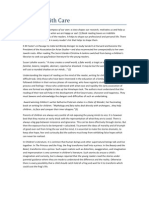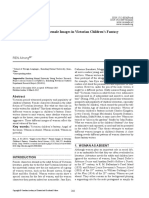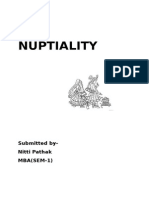Cinderella and Feminism
Cinderella and Feminism
Uploaded by
John VicenteCopyright:
Available Formats
Cinderella and Feminism
Cinderella and Feminism
Uploaded by
John VicenteCopyright
Available Formats
Share this document
Did you find this document useful?
Is this content inappropriate?
Copyright:
Available Formats
Cinderella and Feminism
Cinderella and Feminism
Uploaded by
John VicenteCopyright:
Available Formats
Cinderella and Feminism
Fairy tales are a way for literature to uphold the patriarchal conventions of society. These “harmless”
stories are presented to children at a young age, which then establish the normality of the domination
of men in their minds. Social conventions are instituted to children through fairy tale characters that
they can relate to in order to embed the “proper” gender behaviors in their brains. “American literature
is male. To read the canon of what is currently considered classic American literature is perforce to
identify as male” (Fetterley), but fairy tales come before school years, therefore it is necessary to have
main female characters. Little girls must learn their place in society before they start their education,
because then they will be less likely to question tradition if it has been presented to them so early on. If
girls identify with characters like Cinderella, then they will not need female literature in canon, since
they already have their gender identification set up. Cinderella is the perfect example of a beautiful,
quiet, nurturing, and subordinate woman that little girls relate to.
Cinderella is the image of the ideal angelic female, while the stepmother and stepsisters represent the
opposite “monster” images (Gilbert and Gubar 812). Starting with the physical appearance, Cinderella is
beautiful and the others are dark and unattractive. Cinderella has a magical connection with the animals,
which reinforces the deep connection to nature that a proper woman should have. That quality also
reveals her nurturing nature, because she clothes, feeds, and defends the living creatures she has such a
close bond to. Those actions mirror what kind of mother, wife, and caretaker she would make in the
future. The stepmother is the scheming, outspoken, dominant, and essentially evil character that forces
Cinderella into servitude in her own house. The evil stepmother represents “the subversive feminine
symbols (witches, evil eye)” (Gilbert and Gubar 814). Cinderella, on the other hand, follows the “conduct
books for ladies [that] proliferated, enjoining young girls to submissiveness, modesty selflessness;
reminding all women that they should be angelic” (Gilbet and Gubar 816). Regardless of how badly the
stepmother treated Cinderella, she went on doing her household duties and taking care of the whole
family, which justifies the idea that “a woman of right feeling should devote herself to the good of
others” (Gilbert and Gubar 816). Cinderella falls in love with the handsome prince, who will complete
her life, and in the end with the help of her animal friends and her goodness she wins the day.
Cinderella’s triumph over the wicked stepmother and stepsisters, displays to the audience that her
female qualities are the ones to be repeated and grained into the unconscious. The “angel” female
defeats the “monster” and in a fairy tale always has a happy ending, which send the wrong sense of
reality to the young girl identifying with that innocent, holy character.
“For every glowing portrait of submissive women enshrined in domesticity, there exists an equally
important negative image that embodies the sacrilegious fiendishness” (Gilbert and Gubar 819) of the
monster. Cinderella is a fairy tale that underlines the patriarchal gender roles, and makes the woman
with a dominant personality to be the villain. Cinderella “a sweet heroine inside the house… is opposed
to a vicious [monster] outside” (Gilbert and Gubar 819), which is the stepmother. Little girls who identify
with Cinderella will wait for their prince charming to fulfill their life and accept subordination and
domesticity as their nature role.
Works Cited
Gilbert, Sandra, and Susan Gubar. Literary Theory: An Anthology. Ed. Julie Rivkin and Michael
Ryan. 2nd ed. Malden: Blackwell, 2004. pg. 812-825 and Ch.3 "On the Politics of
Literature" by Judith Fetterley
You might also like
- Action Plan For Catch Up FridaysDocument7 pagesAction Plan For Catch Up FridaysLeslie Joy Yata Montero100% (5)
- Waking the Witch: Reflections on Women, Magic, and PowerFrom EverandWaking the Witch: Reflections on Women, Magic, and PowerRating: 4 out of 5 stars4/5 (56)
- The Americans Chapter 11 NotesDocument9 pagesThe Americans Chapter 11 NotesPi LoverNo ratings yet
- Hard Times-Questions and AnswersDocument8 pagesHard Times-Questions and AnswersFatma Musallam80% (5)
- The Bloody Chamber' - Angela CarterDocument12 pagesThe Bloody Chamber' - Angela CarterKatie Louise Lambert100% (2)
- A Study Guide for Karen Russell's "St. Lucy's Home for Girls Raised by Wolves"From EverandA Study Guide for Karen Russell's "St. Lucy's Home for Girls Raised by Wolves"No ratings yet
- The StorytellerDocument4 pagesThe StorytellerBrenditacarolain77No ratings yet
- Who's Afraid of The Wicked WitchDocument7 pagesWho's Afraid of The Wicked Witchmslenihan0% (1)
- Heroines JourneyDocument18 pagesHeroines Journeyapi-302514606No ratings yet
- Judith Viorst S PoemDocument2 pagesJudith Viorst S Poemaletse52No ratings yet
- Feminism:-: Patriarchy. A Patriarchal Woman Is The One Who Has Internalized The Norms and Values ofDocument10 pagesFeminism:-: Patriarchy. A Patriarchal Woman Is The One Who Has Internalized The Norms and Values ofAmjad RazaNo ratings yet
- Representation of Women in Contemporary Children's LiteratureDocument6 pagesRepresentation of Women in Contemporary Children's LiteratureAayeshaNo ratings yet
- Sample Essay On Gender in CinderellaDocument3 pagesSample Essay On Gender in CinderellaSharon LaiNo ratings yet
- Women Depiction in Fairy TalesDocument6 pagesWomen Depiction in Fairy TalesSaad SaeedNo ratings yet
- Literature Review: So Far From God by Ana CastilloDocument5 pagesLiterature Review: So Far From God by Ana CastilloProf. MbuiNo ratings yet
- Reawakening the Magic: Reawakening the Magic by Facing the Shadows, #1From EverandReawakening the Magic: Reawakening the Magic by Facing the Shadows, #1No ratings yet
- Overall Analysis of The Courtship of MR Lyon and The Tiger's BrideDocument7 pagesOverall Analysis of The Courtship of MR Lyon and The Tiger's BrideengmisskpNo ratings yet
- Avadanii Ana Catalina-Feminism in Great Expectations by Charles DickensDocument5 pagesAvadanii Ana Catalina-Feminism in Great Expectations by Charles DickensCătălina AvădăniiNo ratings yet
- ENG 300M Response 2Document2 pagesENG 300M Response 2Kristen BaranekNo ratings yet
- Kolbenschlag Article PDFDocument5 pagesKolbenschlag Article PDFTeodora SkrobonjaNo ratings yet
- CINDERELLADocument2 pagesCINDERELLAGemaima CatabayNo ratings yet
- Gender Roles ResearchDocument6 pagesGender Roles Researchahabbinasif90No ratings yet
- Rapunzel CompDocument13 pagesRapunzel CompMario BurkeNo ratings yet
- Angela CarterDocument2 pagesAngela CarterGiovanniNo ratings yet
- The House of The Spirits EssayDocument3 pagesThe House of The Spirits Essaymardue22196No ratings yet
- Rapunzel'S Story Analysis by Using StructuralismDocument1 pageRapunzel'S Story Analysis by Using StructuralismGondoHeafyNo ratings yet
- Witches TalesDocument6 pagesWitches TalesAnna VkNo ratings yet
- Lost and Found: The Orphaned Hero in Myth, Folklore, and Fantasy LL by Terri WindlingDocument4 pagesLost and Found: The Orphaned Hero in Myth, Folklore, and Fantasy LL by Terri WindlingSamlan la HudaNo ratings yet
- Female Symbols at The Crossroads in Disney SDocument12 pagesFemale Symbols at The Crossroads in Disney SLayke ZhangNo ratings yet
- English B TKAM Essay Form 4Document2 pagesEnglish B TKAM Essay Form 4Blasian BrooksNo ratings yet
- Writing With Care - PragyaDocument7 pagesWriting With Care - PragyaPragya KumarNo ratings yet
- Young Women and Wolves - Themes of Sexuality and Identity in Charles Perrault's Little Red Riding Hood and Angela Carter's The Company of WolvesDocument4 pagesYoung Women and Wolves - Themes of Sexuality and Identity in Charles Perrault's Little Red Riding Hood and Angela Carter's The Company of WolvesOuki MilestoneNo ratings yet
- A Comparative Analysis of Fairy Tale Heroes and Heroines Through Gender Lens - Suciu 2015Document8 pagesA Comparative Analysis of Fairy Tale Heroes and Heroines Through Gender Lens - Suciu 2015Gheorghe100% (1)
- Vol 10 X 16 The Modern Cinderellain ChainsDocument4 pagesVol 10 X 16 The Modern Cinderellain ChainsEva S.No ratings yet
- Feminist CriticsmDocument22 pagesFeminist CriticsmAlmaira MagangcongNo ratings yet
- The Looking Glass The WitchesDocument6 pagesThe Looking Glass The WitchesKareena NarwaniNo ratings yet
- Ra First DraftDocument6 pagesRa First Draftapi-311228519No ratings yet
- "Angels in The House": Female Images in Victorian Children's FantasyDocument7 pages"Angels in The House": Female Images in Victorian Children's FantasyIuliana ParaschivNo ratings yet
- 5 A Critical Assessment of PygmalionDocument17 pages5 A Critical Assessment of PygmalionrupsaasukriaNo ratings yet
- Nada 2014Document5 pagesNada 2014Mendacium MendaciumNo ratings yet
- The Wardrobe, The White Witch Has Magical Powers That Children Fear. She Can TurnDocument3 pagesThe Wardrobe, The White Witch Has Magical Powers That Children Fear. She Can Turnxxbbb ddssNo ratings yet
- Gender Roles EssayDocument10 pagesGender Roles EssayHannah NerlichNo ratings yet
- Horace Walpole and Samuel Johnson Champions of Womens RightsDocument5 pagesHorace Walpole and Samuel Johnson Champions of Womens Rightsshilajit biswasNo ratings yet
- Red Riding Hood Analytical EssayDocument4 pagesRed Riding Hood Analytical EssayArya BNNo ratings yet
- The Hunter Maiden: Feminist Folktales from Around the WorldFrom EverandThe Hunter Maiden: Feminist Folktales from Around the WorldRating: 5 out of 5 stars5/5 (2)
- Storytelling EssayDocument5 pagesStorytelling EssayGeorgieNo ratings yet
- The Werewolf (Gothic Mock Exam)Document2 pagesThe Werewolf (Gothic Mock Exam)Lazzie LP100% (1)
- EvaluationsDocument3 pagesEvaluationsMel StoreyNo ratings yet
- FemaleheroeswisebraveandtrickyDocument7 pagesFemaleheroeswisebraveandtrickyapi-302725346No ratings yet
- When The Clock Strikes Essay Final DraftDocument6 pagesWhen The Clock Strikes Essay Final Draftapi-458872254No ratings yet
- AliceDocument4 pagesAliceArushi BhaskarNo ratings yet
- Coraline FinalDocument7 pagesCoraline Finalapi-302725857No ratings yet
- LuppeDocument10 pagesLuppeAshu TyagiNo ratings yet
- Cinderella: A Comparison of The Movies and Books: Shaikha Al-AliDocument4 pagesCinderella: A Comparison of The Movies and Books: Shaikha Al-Alimrlwinmoeforbusi1No ratings yet
- A Sorcerer's Night: The Order of the Black Oak - Warlocks, #2From EverandA Sorcerer's Night: The Order of the Black Oak - Warlocks, #2No ratings yet
- Intercultural Communication - EditedDocument15 pagesIntercultural Communication - EditedJohn VicenteNo ratings yet
- Introducing Literary Theory Lesson PlanDocument7 pagesIntroducing Literary Theory Lesson PlanJohn VicenteNo ratings yet
- Functions of CommunicationDocument9 pagesFunctions of CommunicationJohn Vicente83% (6)
- Reader ResponseDocument17 pagesReader ResponseJohn VicenteNo ratings yet
- Elements of Poetry Elements of PoetryDocument21 pagesElements of Poetry Elements of PoetryJohn Vicente100% (1)
- Marxist Crit of CinderellaDocument1 pageMarxist Crit of CinderellaJohn VicenteNo ratings yet
- Speech Choir Lesson PlanDocument7 pagesSpeech Choir Lesson PlanJohn VicenteNo ratings yet
- Elements of Prose - 1Document39 pagesElements of Prose - 1John VicenteNo ratings yet
- Asian Par DebateDocument11 pagesAsian Par DebateJohn VicenteNo ratings yet
- Lit Elements HandoutDocument4 pagesLit Elements HandoutJohn VicenteNo ratings yet
- Thesis Mentoring Training OutlineDocument3 pagesThesis Mentoring Training OutlineJohn VicenteNo ratings yet
- Elements Short StoryDocument15 pagesElements Short StoryJohn Vicente100% (1)
- Facts Pre-Colonial PhilippinesDocument28 pagesFacts Pre-Colonial PhilippinesJohn VicenteNo ratings yet
- Intercultural CommunicationDocument10 pagesIntercultural CommunicationJohn VicenteNo ratings yet
- Saint Mary's University: Formation Module in Revitalized Homeroom Guidance ProgramDocument4 pagesSaint Mary's University: Formation Module in Revitalized Homeroom Guidance ProgramJohn VicenteNo ratings yet
- DECLAMATION and ORATIONDocument3 pagesDECLAMATION and ORATIONJohn VicenteNo ratings yet
- Speech StylesDocument1 pageSpeech StylesJohn VicenteNo ratings yet
- Intercultural CompetenceDocument13 pagesIntercultural CompetenceJohn VicenteNo ratings yet
- Sources of LawDocument19 pagesSources of Lawआदिम मान्छेNo ratings yet
- Guingona vs. GonzalesDocument3 pagesGuingona vs. GonzalesBeatrice AbanNo ratings yet
- Max Weber The Protestant Ethic and The Spirit of Capitalism: Third Roxbury EditionDocument82 pagesMax Weber The Protestant Ethic and The Spirit of Capitalism: Third Roxbury EditionAndrew RollingsNo ratings yet
- Rizal - Bsba 1 Rizal LawDocument14 pagesRizal - Bsba 1 Rizal LawJenny de LunaNo ratings yet
- Saudi Vision 2030 - WikipediaDocument29 pagesSaudi Vision 2030 - Wikipediawaqasfaiz107No ratings yet
- CW 35 OlDocument159 pagesCW 35 OlEvangeline MatthewsNo ratings yet
- "WHAT BURNS FASTER, MEMORIES OR FLAMES?" -- The LAPD & Media Character Assassination of Michael Hastings and His Fiery Car Crash (Accident or Assassination?) Sept. 14, 2013 [Ver 1.5 Last Updated Nov 21, 2013)Document205 pages"WHAT BURNS FASTER, MEMORIES OR FLAMES?" -- The LAPD & Media Character Assassination of Michael Hastings and His Fiery Car Crash (Accident or Assassination?) Sept. 14, 2013 [Ver 1.5 Last Updated Nov 21, 2013)Guy Montag100% (1)
- Vda de Herrera vs. BernardoDocument11 pagesVda de Herrera vs. BernardokaiNo ratings yet
- Project Mayhem 2012 - 12.21.2012 11.11 - Imagine We Leak It ALL. DHS National Cyber Security and Communications Integration Center Bulletin Warns Against Project Mayhem 2012 - 21 December 2012. PM2012. Expect Us.Document6 pagesProject Mayhem 2012 - 12.21.2012 11.11 - Imagine We Leak It ALL. DHS National Cyber Security and Communications Integration Center Bulletin Warns Against Project Mayhem 2012 - 21 December 2012. PM2012. Expect Us.aannoonn100% (2)
- Child Protection Awareness Raising Training For SchoolsDocument46 pagesChild Protection Awareness Raising Training For SchoolsPich SophoeunNo ratings yet
- Eyewitness Presidents - Dorling KindersleyDocument74 pagesEyewitness Presidents - Dorling KindersleyCavad İbrahimli100% (5)
- RPH Notes MidtermsDocument5 pagesRPH Notes MidtermsKean SaladagaNo ratings yet
- Legal Research: LARIN, Christian John VDocument14 pagesLegal Research: LARIN, Christian John VJason ToddNo ratings yet
- Cead 3rd Merit ListDocument1 pageCead 3rd Merit ListHassanNo ratings yet
- WayToEng4 EP 2-1Document2 pagesWayToEng4 EP 2-1veronica100% (1)
- A. Ocampo - The Fight Over The Rizal LawDocument2 pagesA. Ocampo - The Fight Over The Rizal LawteraNo ratings yet
- The Social Contract by Jean Jacques RousseauDocument2 pagesThe Social Contract by Jean Jacques RousseauJamiah Hulipas33% (3)
- E D Wis - 20302363225Document5 pagesE D Wis - 20302363225J DoeNo ratings yet
- Novai Vs Republic DigestDocument1 pageNovai Vs Republic DigestLen-Len Cobsilen100% (2)
- NuptialityDocument9 pagesNuptialityNitti Pathak100% (1)
- New Leaf Hand BookDocument10 pagesNew Leaf Hand Bookapi-286318375No ratings yet
- Ashcroft 2004 FulltxtDocument12 pagesAshcroft 2004 Fulltxtfafa_mhedzNo ratings yet
- Petitioners Respondents: Made By: Borja, Francesca Tanya RDocument2 pagesPetitioners Respondents: Made By: Borja, Francesca Tanya RCheska BorjaNo ratings yet
- Repatriation of Human ResourcesDocument4 pagesRepatriation of Human ResourcesCesare BorgiaNo ratings yet
- 01122024062555-uxzDocument12 pages01122024062555-uxzmonirhossainbuet23No ratings yet
- UCSP (Week 5)Document4 pagesUCSP (Week 5)Rylin BabagayNo ratings yet
- Divina v. CA, GR 117734, Feb. 22, 2001, 352 SCRA 527Document1 pageDivina v. CA, GR 117734, Feb. 22, 2001, 352 SCRA 527Gia DimayugaNo ratings yet
- CanonPlusDocument123 pagesCanonPlusAntônio100% (5)




